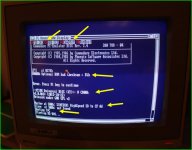WallyB
New Member
PROBLEMS getting "Lo-Tech-Compact Flash Adapter" to initialize in ISA Slot on 8086 XT PC (Amiga Bridgeboard)
Hi,
I've been struggling few a while, trying many way to get a Lo-Tech 8 Bit ISA/IDE CF adapter working on my 8086 PC
The XT PC is is a Bridgeboard Accellerator card that is located inside a Amiga Chassis, (but the card mostly works indepedantly as a PC)
Specifically this version of the Adapter.
https://www.lo-tech.co.uk/wiki/Lo-tech_ISA_CompactFlash_Adapter_revision_2b
I have a two computers to test with to ensure things work (ie Flash Card, SD Card works)
The purpose is to replace my existing old Hard Drive Controller / Hard Drive Combination (WORKING, but too small, too slow, too old):
- The Current Controller is a (ISA 8 Bit) Western Digital (MFM/RLL) HD Controller (Model # WD10020-27X)
http://stason.org/TULARC/pc/hard-disk-floppy-controllers/U-Z/WESTERN-DIGITAL-CORPORATION-Two-RLL-ST506-412-driv-220.html
- The Current Hard Drive is a KALOK Ocatcon KL330 32 Mb
http://www.mfarris.com/hard_drives/kalok/kalok_kl330.html
The above is fully working. Tested by Norton and Spinrite (100% Pass)
Base address is C800, and I've proven I can access it via (MS DOS "debug" via -g c800:5, to Access the interactive Low Level Format BIOS)
I've tried to replace the HD controller/Drive with a (Lo-Tech-Adapter and (IDE Drive, IDE-CF Adapter, IDE-SDcard Adapter), and nothing works in the 8086 XT PC.
To prove that the parts work I also tested in a 486 PC running MS DOS6.2
I tested with a Seagate Maxtor IDE Hard Drive (Works in 486)
http://redhill.net.au/d/23.php
I tested with a Syba IDE to CF Flash Adapter (Works in 486)
http://www.ebay.ca/itm/400815453925?_trksid=p2057872.m2749.l2649&ssPageName=STRK%3AMEBIDX%3AIT
I tested with a Secure Digital IDE to SD Card Adapter (Works in 486)
http://www.ebay.ca/itm/Secure-Digital-44-Pin-2-5-Male-IDE-to-SD-Card-Adapter-Amiga-NEW-SEALED/231881879210?_trksid=p2050601.c100085.m2372&_trkparms=aid%3D111001%26algo%3DREC.SEED%26ao%3D1%26asc%3D20140211132617%26meid%3D3157e9d1010e40b2a504a849f915bc55%26pid%3D100085%26rk%3D4%26rkt%3D4%26sd%3D151135715827%26clkid%3D2823388398356560022&_qi=RTM2247628
They all work in some way in the 486 (Directly attached via BIOS/Montherboard) and work with ISA/IDE adapter (on the same 486)
None of the POSSIBLE combination work in the 8086 setup on the ISA/IDE Adapter
I even tried two versions of the X-IDE Image
- The standard Image
https://www.lo-tech.co.uk/downloads/XT-IDE/lo-tech-isa-compactflash-adapter/xtide-r566-xt-cf-master-slave.zip
- and the Late Init version for Tandy
https://www.lo-tech.co.uk/downloads/XT-CF/ISA-CF-BIOS-r567-late-init.zip
None of above work in the 8086, but both work in the 486 (with a small glitch on the ISA/IDE adapter and Compact Flash)
In all configurations, I am picking up the Storage device as Master.
*** WHAT HAS BEEN NOTICED IS THIS ***
- Using the DEBUG "-g c800:0", I can see the lo-tech ISA/IDE adapter. I see the text for the banner message in Base Memory Location (I can also change jump and shift locations).
- ABOVE I see in 486 and 8086 (same location)
But in the 8086 it won't the ISA/IDE Card Won't Initialize.
Note the WD Controller on the same c800 address does initialize and I have a working C: Drive
I can provide more information, or do more tests.
Looking for some advice on how to debug more?
Maybe another X-IDE image to try (a mod)
Appreciate any assistance.
Here is a summary of the test configuration's and results in a PICTORAL TABLE
https://www.flickr.com/photos/147613604@N08/32955273971/in/dateposted-public/
If anyone is interested in the Arctecture of the Amiga and Bridgeboard, here is the design of the computer in detail
https://archive.org/details/Commodore_Amiga_A500_A2000_Technical_Reference_Manual_1987_Commodore
Hi,
I've been struggling few a while, trying many way to get a Lo-Tech 8 Bit ISA/IDE CF adapter working on my 8086 PC
The XT PC is is a Bridgeboard Accellerator card that is located inside a Amiga Chassis, (but the card mostly works indepedantly as a PC)
Specifically this version of the Adapter.
https://www.lo-tech.co.uk/wiki/Lo-tech_ISA_CompactFlash_Adapter_revision_2b
I have a two computers to test with to ensure things work (ie Flash Card, SD Card works)
The purpose is to replace my existing old Hard Drive Controller / Hard Drive Combination (WORKING, but too small, too slow, too old):
- The Current Controller is a (ISA 8 Bit) Western Digital (MFM/RLL) HD Controller (Model # WD10020-27X)
http://stason.org/TULARC/pc/hard-disk-floppy-controllers/U-Z/WESTERN-DIGITAL-CORPORATION-Two-RLL-ST506-412-driv-220.html
- The Current Hard Drive is a KALOK Ocatcon KL330 32 Mb
http://www.mfarris.com/hard_drives/kalok/kalok_kl330.html
The above is fully working. Tested by Norton and Spinrite (100% Pass)
Base address is C800, and I've proven I can access it via (MS DOS "debug" via -g c800:5, to Access the interactive Low Level Format BIOS)
I've tried to replace the HD controller/Drive with a (Lo-Tech-Adapter and (IDE Drive, IDE-CF Adapter, IDE-SDcard Adapter), and nothing works in the 8086 XT PC.
To prove that the parts work I also tested in a 486 PC running MS DOS6.2
I tested with a Seagate Maxtor IDE Hard Drive (Works in 486)
http://redhill.net.au/d/23.php
I tested with a Syba IDE to CF Flash Adapter (Works in 486)
http://www.ebay.ca/itm/400815453925?_trksid=p2057872.m2749.l2649&ssPageName=STRK%3AMEBIDX%3AIT
I tested with a Secure Digital IDE to SD Card Adapter (Works in 486)
http://www.ebay.ca/itm/Secure-Digital-44-Pin-2-5-Male-IDE-to-SD-Card-Adapter-Amiga-NEW-SEALED/231881879210?_trksid=p2050601.c100085.m2372&_trkparms=aid%3D111001%26algo%3DREC.SEED%26ao%3D1%26asc%3D20140211132617%26meid%3D3157e9d1010e40b2a504a849f915bc55%26pid%3D100085%26rk%3D4%26rkt%3D4%26sd%3D151135715827%26clkid%3D2823388398356560022&_qi=RTM2247628
They all work in some way in the 486 (Directly attached via BIOS/Montherboard) and work with ISA/IDE adapter (on the same 486)
None of the POSSIBLE combination work in the 8086 setup on the ISA/IDE Adapter
I even tried two versions of the X-IDE Image
- The standard Image
https://www.lo-tech.co.uk/downloads/XT-IDE/lo-tech-isa-compactflash-adapter/xtide-r566-xt-cf-master-slave.zip
- and the Late Init version for Tandy
https://www.lo-tech.co.uk/downloads/XT-CF/ISA-CF-BIOS-r567-late-init.zip
None of above work in the 8086, but both work in the 486 (with a small glitch on the ISA/IDE adapter and Compact Flash)
In all configurations, I am picking up the Storage device as Master.
*** WHAT HAS BEEN NOTICED IS THIS ***
- Using the DEBUG "-g c800:0", I can see the lo-tech ISA/IDE adapter. I see the text for the banner message in Base Memory Location (I can also change jump and shift locations).
- ABOVE I see in 486 and 8086 (same location)
But in the 8086 it won't the ISA/IDE Card Won't Initialize.
Note the WD Controller on the same c800 address does initialize and I have a working C: Drive
I can provide more information, or do more tests.
Looking for some advice on how to debug more?
Maybe another X-IDE image to try (a mod)
Appreciate any assistance.
Here is a summary of the test configuration's and results in a PICTORAL TABLE
https://www.flickr.com/photos/147613604@N08/32955273971/in/dateposted-public/
If anyone is interested in the Arctecture of the Amiga and Bridgeboard, here is the design of the computer in detail
https://archive.org/details/Commodore_Amiga_A500_A2000_Technical_Reference_Manual_1987_Commodore

